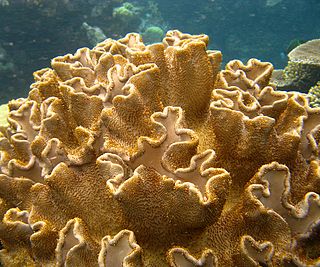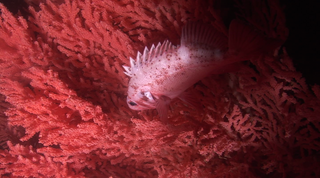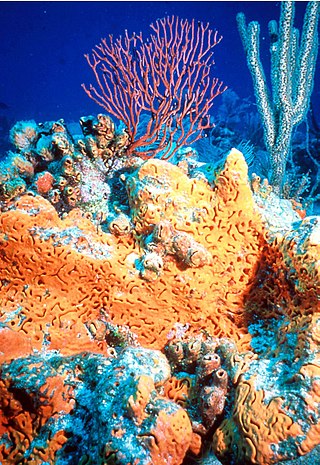
Corals are colonial marine invertebrates within the class Anthozoa of the phylum Cnidaria. They typically form compact colonies of many identical individual polyps. Coral species include the important reef builders that inhabit tropical oceans and secrete calcium carbonate to form a hard skeleton.

Anthozoa is a class of marine invertebrates which includes the sea anemones, stony corals and soft corals. Adult anthozoans are almost all attached to the seabed, while their larvae can disperse as part of the plankton. The basic unit of the adult is the polyp; this consists of a cylindrical column topped by a disc with a central mouth surrounded by tentacles. Sea anemones are mostly solitary, but the majority of corals are colonial, being formed by the budding of new polyps from an original, founding individual. Colonies are strengthened by calcium carbonate and other materials and take various massive, plate-like, bushy or leafy forms.

Sea pens are colonial marine cnidarians belonging to the order Pennatulacea. The order Pennatulacea, commonly known as sea pens, are colony-forming benthos belonging within subclass Octocorallia. Sea pens are found worldwide from shallow to deep waters, and they are important components in sandy and muddy environments. Thus far, there has been only one molecular study focusing on the phylogenetic relationships within the order Pennatulacea, which mainly treated deep-sea species, and thus information on shallow water species is still lacking. There are 14 families within the order and 35 extant genera; it is estimated that of 450 described species, around 200 are valid. Sea pens have a cosmopolitan distribution, being found in tropical and temperate waters worldwide, as well as from the intertidal to depths of more than 6100 m. Sea pens are grouped with the octocorals, together with sea whips (gorgonians).

Alcyonacea are an order of sessile colonial cnidarians that are found throughout the oceans of the world, especially in the deep sea, polar waters, tropics and subtropics. Whilst not in a strict taxonomic sense, Alcyonacea are commonly known as soft corals. The term “soft coral” generally applies to organisms in the two orders Pennatulacea and Alcyonacea with their polyps embedded within a fleshy mass of coenenchymal tissue. Consequently, the term “gorgonian coral” is commonly handed to multiple species in the order Alcyonacea that produce a mineralized skeletal axis composed of calcite and the proteinaceous material gorgonin only and corresponds to only one of several families within the formally accepted taxon Gorgoniidae (Scleractinia). These can be found in order Malacalcyonacea (taxonomic synonyms of include : Alcyoniina, Holaxonia, Protoalcyonaria, Scleraxonia, and Stolonifera. They are sessile colonial cnidarians that are found throughout the oceans of the world, especially in the deep sea, polar waters, tropics and subtropics. Common names for subsets of this order are sea fans and sea whips; others are similar to the sea pens of related order Pennatulacea. Individual tiny polyps form colonies that are normally erect, flattened, branching, and reminiscent of a fan. Others may be whiplike, bushy, or even encrusting. A colony can be several feet high and across, but only a few inches thick. They may be brightly coloured, often purple, red, or yellow. Photosynthetic gorgonians can be successfully kept in captive aquaria.

Hexacorallia is a class of Anthozoa comprising approximately 4,300 species of aquatic organisms formed of polyps, generally with 6-fold symmetry. It includes all of the stony corals, most of which are colonial and reef-forming, as well as all sea anemones, and zoanthids, arranged within five extant orders. The hexacorallia are distinguished from another class of Anthozoa, Octocorallia, in having six or fewer axes of symmetry in their body structure; the tentacles are simple and unbranched and normally number more than eight. These organisms are formed of individual soft polyps which in some species live in colonies and can secrete a calcite skeleton. As with all Cnidarians, these organisms have a complex life cycle including a motile planktonic phase and a later characteristic sessile phase. Hexacorallia also include the significant extinct order of rugose corals.

Sea anemones are a group of predatory marine invertebrates constituting the order Actiniaria. Because of their colourful appearance, they are named after the Anemone, a terrestrial flowering plant. Sea anemones are classified in the phylum Cnidaria, class Anthozoa, subclass Hexacorallia. As cnidarians, sea anemones are related to corals, jellyfish, tube-dwelling anemones, and Hydra. Unlike jellyfish, sea anemones do not have a medusa stage in their life cycle.

Alcyoniidae is a family of leathery or soft corals in the phylum Cnidaria.

Coralliidae, also known as precious corals, is a taxonomic family of soft corals belonging to the suborder Scleraxonia of the phylum Cnidaria. These sessile corals are one of the most dominant members of hard-bottomed benthic environments such as seamounts, canyons and continental shelves. From this coral family results 69 descendants in which each species plays a key role in forming habitats for a variety of marine species.

Helioporacea is an order of the subclass Octocorallia that forms massive lobed crystalline calcareous skeletons in colonial corals. These corals first appeared in the Cretaceous period. It consists of two families, Helioporidae Moseley, 1876 and Lithotelestidae Bayer & Muzik, 1977.

Leptogorgia virgulata, commonly known as the sea whip or colorful sea whip, is a species of soft coral in the family Gorgoniidae.

Nephtheidae is a family of soft corals in the phylum Cnidaria. Members of this family are known as carnation corals, tree corals or colt soft corals. They are very attractive and show a wide range of rich and pastel colours including reds, pinks, yellows and purples. They are popular with reef aquarium hobbyists.

Primnoa(Lamororux, 1812) also known as red tree coral, is a genus of soft corals and the type genus of the family Primnoidae (Milne Edwards, 1857). They are sessile, benthic cnidarians that can be found in the North Pacific, North Atlantic, and Subantarctic South Pacific, and its members often play a vital ecological role as keystone species within their environment as a habitat and refuge for the megafauna that also inhabit those regions. This, in combination with their slow growth, makes the increasing disturbance to their habitats caused by fishing activities particularly impactful and difficult to recover from.

Plexaurella nutans, the giant slit-pore sea rod, is a tall species of soft coral in the family Plexauridae. It is a relatively uncommon species and is found in shallow seas in the Caribbean region.

Litophyton arboreum, also known as broccoli coral, is a common soft coral (octocoral) found from the Red Sea to the Western Pacific. It grows up to 80 cm, usually on seaward reef slopes or hard bottoms. The color of L. arboreum varies from pale olive-green to yellow or grey. L. arboreum are anthozoans in the order Alcyonacea in the family Nephtheidae. The L. arboreum was originally classified in 1775 by Peter Forsskål, a Swedish Linnaean naturalist. As of 2016, the entire genus Litophyton was reclassified using phylogenetic data, in contrast to its original morphological classification.

Alcyonium coralloides, commonly known as false coral, is a colonial species of soft coral in the family Alcyoniidae. It is native to the northeastern Atlantic Ocean and the Mediterranean Sea. In the former location it generally grows as sheets or small lobes but in the latter it is parasitic and overgrows sea fans.
Taiaroa is a genus of deep-water, solitary marine octocorals in the family Taiaroidae. Taiaroa is monotypic in the family Taiaroidae and contains a single species, Taiaroa tauhou. The species was first described by the marine zoologists Frederick M. Bayer and Katherine Margaret Muzik in 1976. The scientific name derives from "Taiaroa", the submarine canyon off New Zealand in which the first specimens were found and "tauhou", the Maori word for "strange".

In zoology, a mesentery is a membrane inside the body cavity of an animal. The term identifies different structures in different phyla: in vertebrates it is a double fold of the peritoneum enclosing the intestines; in other organisms it forms complete or incomplete partitions of the body cavity, whether that is the coelom or, as in the Anthozoa, the gastrovascular cavity.

Callogorgia is a genus of deep sea corals that are ideally suited to be habitats for different organisms. They reproduce both sexually and asexually, clinging to the hard substrate of the ocean during their maturation process. Callogorgia are found at depths ranging from 750-8200 feet in the Gulf of Mexico, Pacific Ocean and the Caribbean Sea. An array of organisms have relationships with Callogorgia, including brittle stars, cat sharks, and copepods. The nature of these relationships are often commensal, with Callogorgia providing a habitat for the organisms.
Callogorgia elegans is a species of soft corals in the family Primnoidae. It is found in the north-western Pacific Ocean. Like other coral species, C. elegans is bottom-dwelling and sessile, or immobile.

Narella is a genus of deep-sea soft corals in the family Primnoidae (Milne Edwards, 1857). They are sessile, bottom-dwelling organisms that can be found in all ocean basins, having cosmopolitan distribution. They have a branching appearance.

















